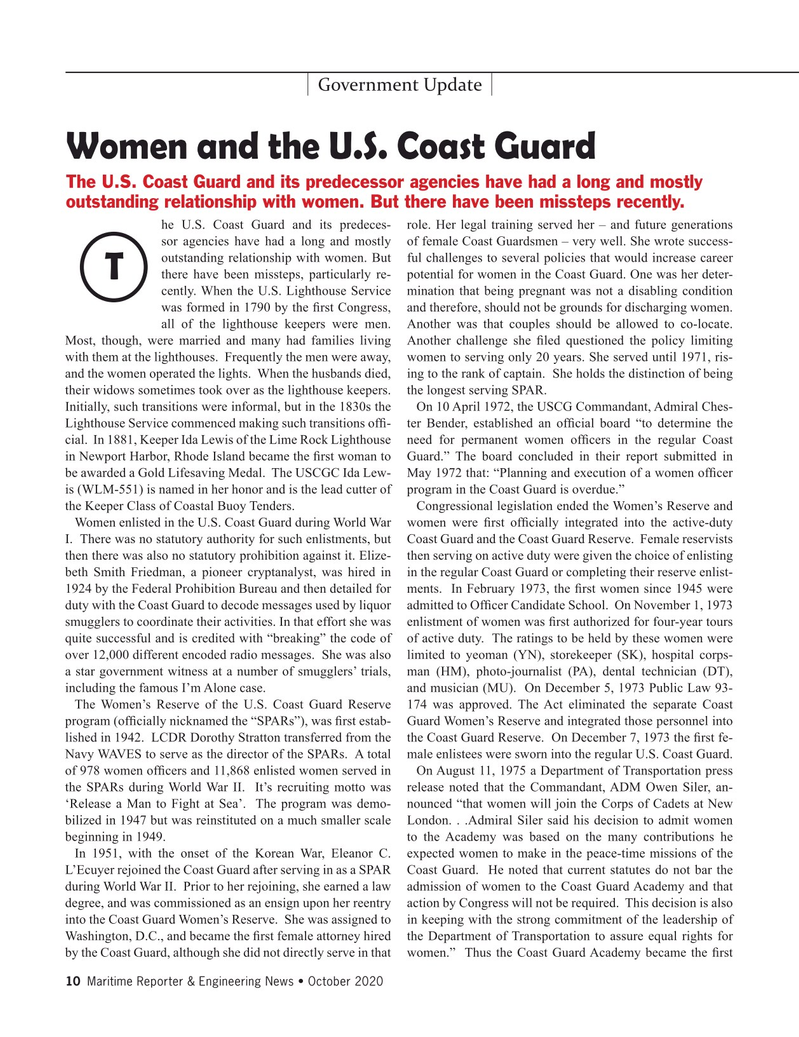
Page 10: of Maritime Reporter Magazine (October 2020)
Shipping & Port Annual
Read this page in Pdf, Flash or Html5 edition of October 2020 Maritime Reporter Magazine
Government Update
Women and the U.S. Coast Guard
The U.S. Coast Guard and its predecessor agencies have had a long and mostly outstanding relationship with women. But there have been missteps recently.
he U.S. Coast Guard and its predeces- role. Her legal training served her – and future generations sor agencies have had a long and mostly of female Coast Guardsmen – very well. She wrote success- outstanding relationship with women. But ful challenges to several policies that would increase career there have been missteps, particularly re- potential for women in the Coast Guard. One was her deter-
T cently. When the U.S. Lighthouse Service mination that being pregnant was not a disabling condition was formed in 1790 by the ? rst Congress, and therefore, should not be grounds for discharging women. all of the lighthouse keepers were men. Another was that couples should be allowed to co-locate.
Most, though, were married and many had families living Another challenge she ? led questioned the policy limiting with them at the lighthouses. Frequently the men were away, women to serving only 20 years. She served until 1971, ris- and the women operated the lights. When the husbands died, ing to the rank of captain. She holds the distinction of being their widows sometimes took over as the lighthouse keepers. the longest serving SPAR.
Initially, such transitions were informal, but in the 1830s the On 10 April 1972, the USCG Commandant, Admiral Ches-
Lighthouse Service commenced making such transitions of? - ter Bender, established an of? cial board “to determine the cial. In 1881, Keeper Ida Lewis of the Lime Rock Lighthouse need for permanent women of? cers in the regular Coast in Newport Harbor, Rhode Island became the ? rst woman to Guard.” The board concluded in their report submitted in be awarded a Gold Lifesaving Medal. The USCGC Ida Lew- May 1972 that: “Planning and execution of a women of? cer is (WLM-551) is named in her honor and is the lead cutter of program in the Coast Guard is overdue.” the Keeper Class of Coastal Buoy Tenders. Congressional legislation ended the Women’s Reserve and
Women enlisted in the U.S. Coast Guard during World War women were ? rst of? cially integrated into the active-duty
I. There was no statutory authority for such enlistments, but Coast Guard and the Coast Guard Reserve. Female reservists then there was also no statutory prohibition against it. Elize- then serving on active duty were given the choice of enlisting beth Smith Friedman, a pioneer cryptanalyst, was hired in in the regular Coast Guard or completing their reserve enlist- 1924 by the Federal Prohibition Bureau and then detailed for ments. In February 1973, the ? rst women since 1945 were duty with the Coast Guard to decode messages used by liquor admitted to Of? cer Candidate School. On November 1, 1973 smugglers to coordinate their activities. In that effort she was enlistment of women was ? rst authorized for four-year tours quite successful and is credited with “breaking” the code of of active duty. The ratings to be held by these women were over 12,000 different encoded radio messages. She was also limited to yeoman (YN), storekeeper (SK), hospital corps- a star government witness at a number of smugglers’ trials, man (HM), photo-journalist (PA), dental technician (DT), including the famous I’m Alone case. and musician (MU). On December 5, 1973 Public Law 93-
The Women’s Reserve of the U.S. Coast Guard Reserve 174 was approved. The Act eliminated the separate Coast program (of? cially nicknamed the “SPARs”), was ? rst estab- Guard Women’s Reserve and integrated those personnel into lished in 1942. LCDR Dorothy Stratton transferred from the the Coast Guard Reserve. On December 7, 1973 the ? rst fe-
Navy WAVES to serve as the director of the SPARs. A total male enlistees were sworn into the regular U.S. Coast Guard. of 978 women of? cers and 11,868 enlisted women served in On August 11, 1975 a Department of Transportation press the SPARs during World War II. It’s recruiting motto was release noted that the Commandant, ADM Owen Siler, an- ‘Release a Man to Fight at Sea’. The program was demo- nounced “that women will join the Corps of Cadets at New bilized in 1947 but was reinstituted on a much smaller scale London. . .Admiral Siler said his decision to admit women beginning in 1949. to the Academy was based on the many contributions he
In 1951, with the onset of the Korean War, Eleanor C. expected women to make in the peace-time missions of the
L’Ecuyer rejoined the Coast Guard after serving in as a SPAR Coast Guard. He noted that current statutes do not bar the during World War II. Prior to her rejoining, she earned a law admission of women to the Coast Guard Academy and that degree, and was commissioned as an ensign upon her reentry action by Congress will not be required. This decision is also into the Coast Guard Women’s Reserve. She was assigned to in keeping with the strong commitment of the leadership of
Washington, D.C., and became the ? rst female attorney hired the Department of Transportation to assure equal rights for by the Coast Guard, although she did not directly serve in that women.” Thus the Coast Guard Academy became the ? rst 10 Maritime Reporter & Engineering News • October 2020
MR #10 (1-17).indd 10 10/6/2020 8:34:24 AM

 9
9

 11
11
